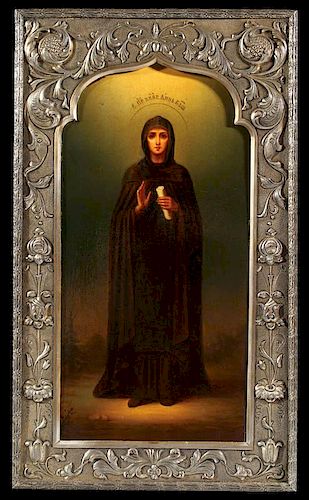IMPORTANT IMPERIAL RUSSIAN PRESENTATION ICON
About Seller
2229 Lincoln Street
Cedar Falls, IA 50613
United States
Founded in 1969, Jackson’s International Auctioneers and Appraisers has grown to become one of the nation’s premier service providers for the sale and appraisal of antiques and fine art. Our regularly scheduled auctions bring to market a broad array of objects, including Russian icons, Old Master pa...Read more
Two ways to bid:
- Leave a max absentee bid and the platform will bid on your behalf up to your maximum bid during the live auction.
- Bid live during the auction and your bids will be submitted real-time to the auctioneer.
Bid Increments
| Price | Bid Increment |
|---|---|
| $0 | $10 |
| $100 | $25 |
| $500 | $50 |
| $1,000 | $100 |
| $2,000 | $200 |
| $5,000 | $500 |
| $10,000 | $1,000 |
About Auction
Jun 16, 2015 - Jun 17, 2015
Jackson's International Auctioneers and Appraisers accounting@jacksonsauction.com
- Lot Description
AN IMPORTANT IMPERIAL RUSSIAN PRESENTATION ICON OF SAINT ANNA KASHINSKAYA, VLADIMIROV, ST. PETERSBURG, 1909. Within an ogee arched reserve, a full length figure of a female monastic saint identified by the inscription in her halo as The Holy Venerable Princess Anna Kashinskaya. Overlaid with an exceptionally well crafted silver gilt repousse and chased riza in the Art Nouveau taste. The verso covered in faded velvet and with applied silver gilt plaque engraved in Cyrillic script reading To Her Highness Queen Olga Konstantinovna Blessing of the Loyal Homeland from Prince Mikhail Andronikov September 1909. The riza hallmarked St. Petersburg, 1908-1917 and Cyrillic maker's mark VLADIMIROV and with 84 standard. 13 inches x 8.6 inches (32.5 x 19 cm).
Grand Duchess Olga (1851-1926) of Russia was born on September 3, 1851, to Grand Duke Constantine Nikolaievich (son of Tsar Nicholas I). She spent her childhood in St. Petersburg, Poland and the Crimea. In 1867, at the age of 16, she married King George I of Greece. At first, she felt ill at ease in the Kingdom of Greece, but she quickly became involved in social and charitable work and was held in high esteem by her new country. Upon the assassination of her husband in 1913, Olga returned to Russia. When the First World War broke out, she set up a military hospital in Pavlovsk Palace, which belonged to her brother. However, after the Revolution of 1917, she became trapped in the palace until the Danish embassy intervened, allowing her to escape to Switzerland. Nevertheless, Olga could not return to Greece as her son, King Constantine I, had been deposed. However later, in October of 1920, she returned to Athens upon the fatal illness of her grandson, King Alexander. After his death, she was appointed Regent until the restoration of Constantine I the following month. After the defeat of the Greeks in the Greco-Turkish war of 1919-22, the Greek Royal Family was again exiled and Olga spent the last years of her life in the United Kingdom, France, and Italy where she died in 1926. Princess Olga is the grandmother of Prince Philip, Duke of Edinburgh, husband of Queen Elizabeth II.
Prince Mikhail Andronikov (1867-1919) was a colorful and restless, if not altogether controversial figure. Born into privilege, he studied at the Corps du Pages but was dismissed. From 1897-1914, he was attached to the Ministry of Internal Affairs. He was close friends with the self-proclaimed monk Grigoriy Rasputin representing him at court. In 1916, he fell out of favor with Rasputin and by default with the Empress Alexandra. In 1917, on suspicions of spying for Germany, Andronikov was exiled from St. Petersburg and Moscow. After the Revolution, on the recommendation of Lenin and Dzerzhinsky, he was appointed head of the Kronstadt Cheka. After having been caught red handed receiving massive bribes and then sending the money out of country for safe keeping, he was arrested and tried, not for embezzlement, but on charges of spying for Germany for which he was executed in 1919.
Princess Anna Kashin (1280 - 2 October 1368) was a Russian princess from the Rurik Dynasty. In 1324, she married Prince Mikhail of Tver and together they had five children. After the death of her husband, Anna carried out an old desire "in silence to work only for God." She took vows in Sofia's Monastery in Tver and adopted the name Evfrosiniya. In 1365, the youngest son of the princess, Vasiliy, her only child remaining alive by that time, entreated his mother to move to his principality. The Upensky Monastery was built in Kashin, and there the saint accepted the schema with the name of Anna. She died of old age on 2 October 1368, and was buried in the cathedral temple of the Blessed Virgin.
The name of Princess Anna was forgotten for many centuries. It was during the 1611 siege of Kashin by Lithuanian troops that Anna appeared to Gerasim, Sexton of the Dormition Cathedral, and it is said that she prayed to the Saviour and Our Lady for deliverance of her city from foreigners. Her relics were reported to work miracles. The synod of the Russian Orthodox Church convened in 1649 and declared her relics worthy of a universal homage. The princess was glorified as a saint. 28 years later, Patriarch Joachim addressed the Moscow Synod with a suggestion to decanonize her because of the uncommon veneration and esteem for Anna among the Old Believers. It was traditionally thought the Old Believers chose Anna as their palladium because the princess was represented on icons as making the Sign of the Cross with two fingers, as the Old Believers practiced, rather than with three, as official church policy required after Patriarch Nikon in 1656. However, writings used by the Old Believers show that one of the reasons they venerated her so highly was that her incorrupt body, on display, showed her hand in the two-fingered Sign of the Cross favoured by the Old Believers, vindicating their stance. Despite numerous efforts of the Church authorities to "correct" the situation, her hand always went back to the same two-fingered position. In response, Patriarch Joachim removed the relics of Anna from public view. In 1678, the Grand Council of the Russian Orthodox Church, decanonized Anna of Kashin permitting only prayer for her. It was not until 1909 that the Russian Orthodox Church glorified Anna again.
Based on the date inscribed on the dedicatory plaque of the offered icon, it would seem that it was related to two events simultaneously, the birthday of Queen Olga (September) and the year in which Saint Anna Kashinskaya was once again glorified by the church (1909). - Shipping Info
-
All successful absentee bidders may request a shipping quote for Jackson’s International to provide shipping to be sent with their invoice. This shipping quote includes the cost of standard shipping as well as charges for materials and labor. Please indicate any special shipping instructions on the bid form. Purchases paid by personal check will not be shipped until funds have cleared Auctioneer's bank. Please note that International shipping is not available for ivory items. These items will only be shipped within the United States, except to California, Connecticut, New Jersey, and New York. All buyers agree to comply with any additional restrictions regarding the trade of endangered species as a condition of sale. It is the purchaser’s responsibility to obtain any licenses and/or certificates as well as any other required documentation prior to shipment. In the case of denial or delay of any required documentation or paperwork, they buyer will still be responsible for making on-time payment for the total purchase price of the lot. Therefore, if you are unsure, Jackson’s recommend that you DO NOT BID on ivory items. We support the ban on the sale of non-antique carved ivory objects of art.
-
- Buyer's Premium



 EUR
EUR CAD
CAD AUD
AUD GBP
GBP MXN
MXN HKD
HKD CNY
CNY MYR
MYR SEK
SEK SGD
SGD CHF
CHF THB
THB

















